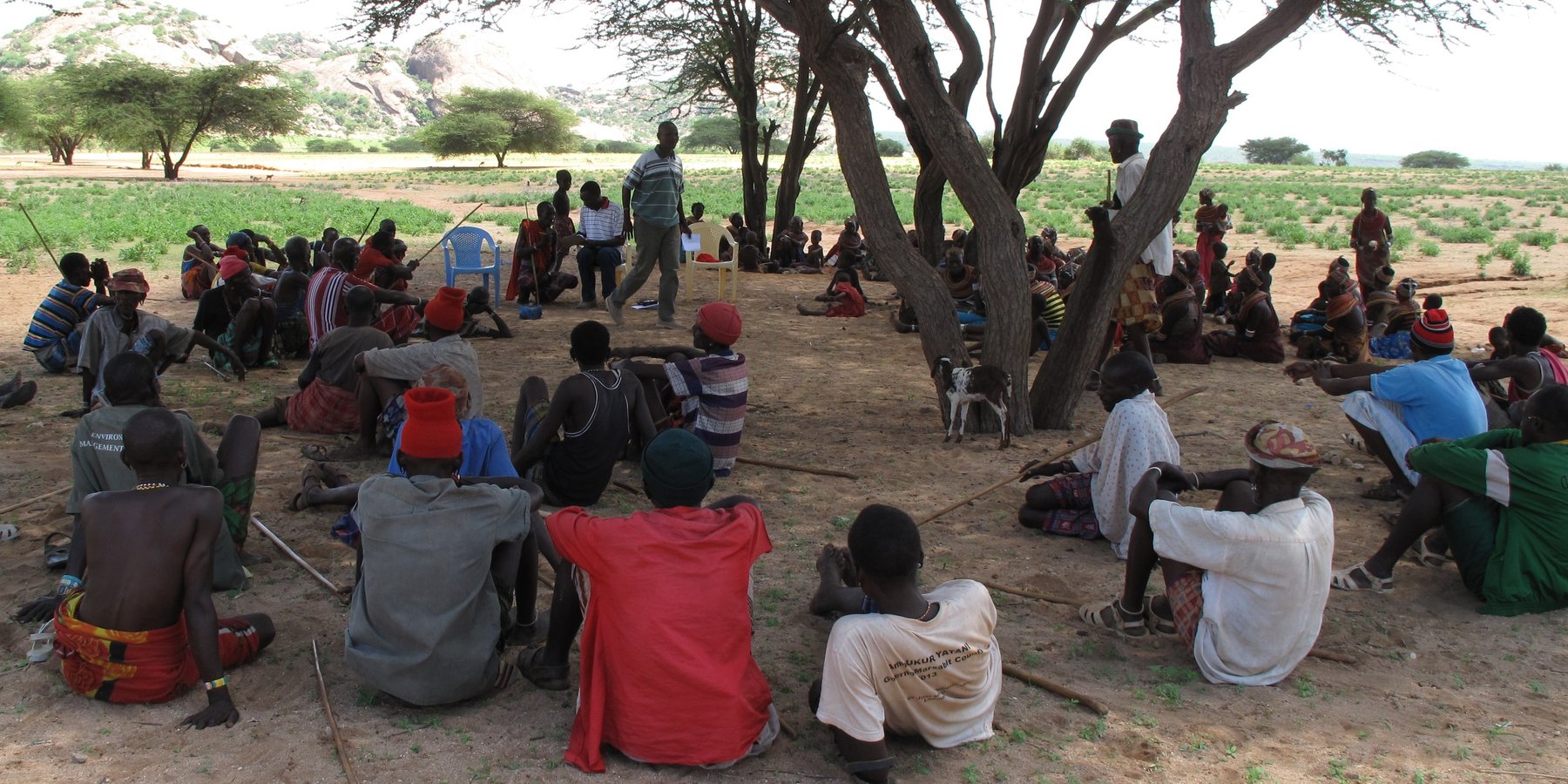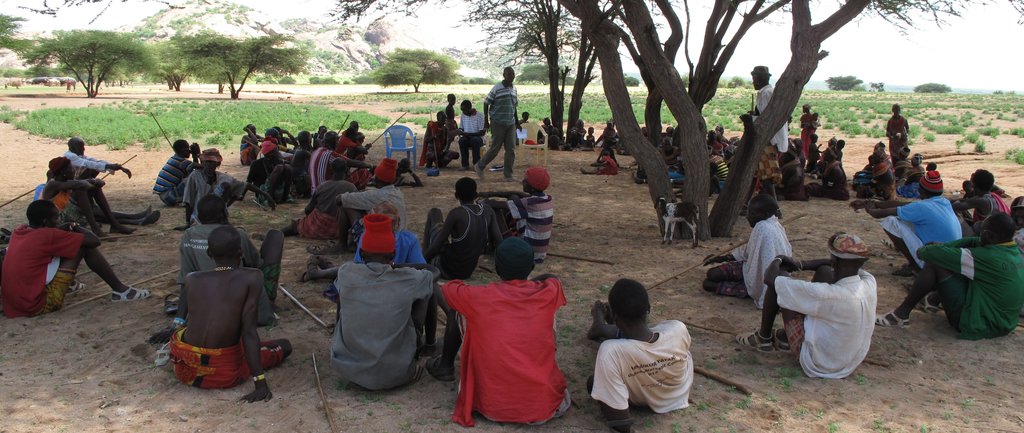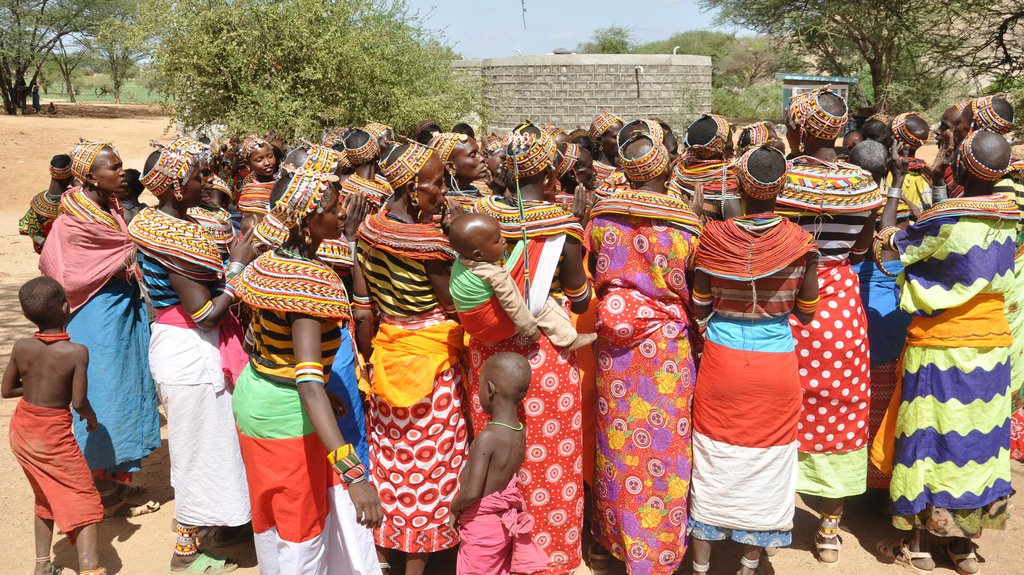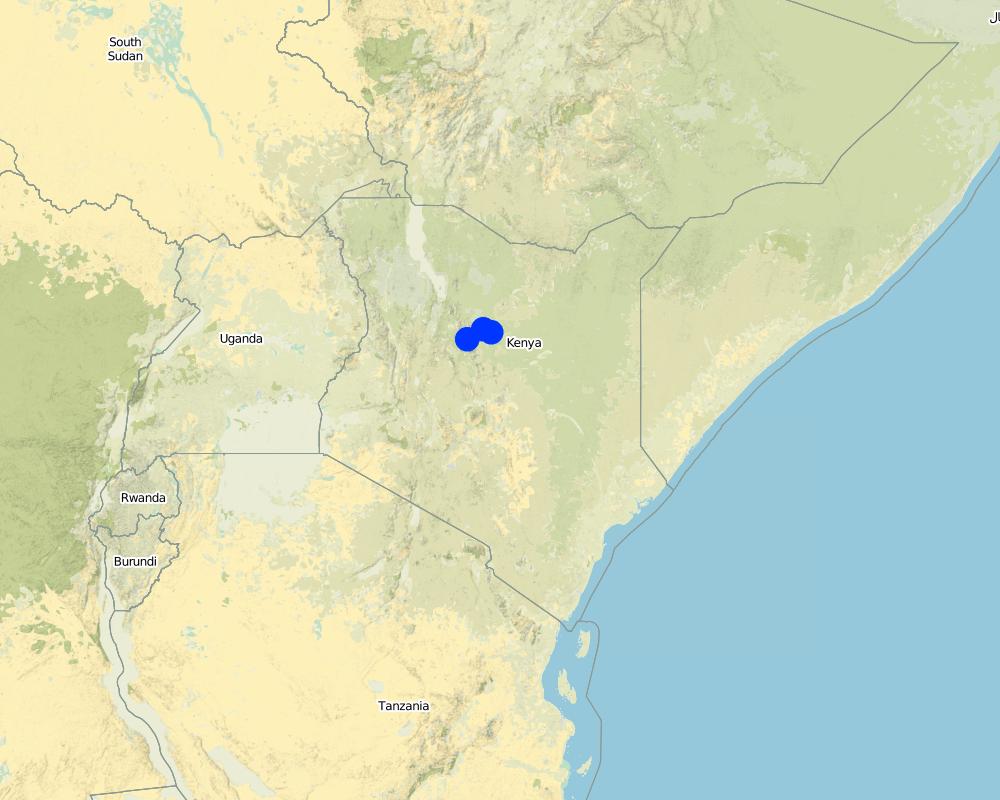Partnership with beneficiary communities in project implementation [Кения]
- Создание:
- Обновить:
- Составитель: Fredrick Ochieng
- Редакторы: Boris Orlowsky, Nicole Stolz
- Рецензенты: Renate Fleiner, Boris Orlowsky, Alexandra Gavilano
N/A
approaches_597 - Кения
Просмотреть разделы
Развернуть все Свернуть все1. Общая информация
1.2 Контактные данные специалистов и организаций, участвующих в описании и оценке Подхода
Ответственный (-ые) специалист (-ы)
Fredrick Ochieng:
Кения
Название организации (-ий), содействовавших документированию/оценке Подхода (если применимо)
CARITAS (Switzerland) - Швейцария1.3 Условия, регламентирующие использование собранных ВОКАТ данных
Когда были собраны данные (на местах)?
14/10/2016
Составитель и ответственный/-ые специалист(-ы) согласны с условиями, регламентирующими использование собранных ВОКАТ данных:
Да
1.4 Ссылка (-и) на Анкету (-ы) по Технологиям УЗП
2. Описание Подхода УЗП
2.1 Краткое описание Подхода
The approach focuses on community engagement on a partnership basis. The model is a departure from the traditional approaches where the community mostly is reduced to being a beneficiary of project services without substantive responsibility.
2.2 Подробное описание Подхода
Подробное описание Подхода:
The Approach is hinged on community empowerment and partnership. The model is a departure from the traditional approaches where the community is reduced to a mere beneficiary of project services without substantive responsibility.
The main purpose of the approach is to enhance ownership, while fostering needed capacity for management of project outcomes. Ultimately, it is estimated that sustainability of project results is achievable with good community empowerment and meaningful participation. The approach also aims at cost effectiveness as the community is required to substantially contribute locally available materials, labour and sometimes cash.
Community mobilisation and capacity building is central to ensure that the community is prepared to undertake their roles and responsibilities. Mobilisation happens through discussions, sometimes aided by applying participatory tools and methods. Capacity building is done through workshop-type and/or on-the-job training. It is noteworthy that the communities do have indigenous knowledge and skills which are useful in processes of development at the community level. These skills and knowledge inform the project design, planning and implementation of activities. To enhance local skills, selected community members are trained as they work alongside the hired skilled artisans during the construction of the rock catchment system. The aim is to prepare and equip the locals with basic skills for operations and maintenance of the rock catchment system. Others are trained to get equipped with skills on hygiene and sanitation promotion.
The project was designed based on pre-project assessment. The assessment, besides identifying water and hygiene needs, also identified three areas/communities which had rock catchment potential - Ndikir, Manyatta Lengima and Mpagas. Initial meetings were done with support from community leaders and the local government administrators (chiefs). During the meetings the project was explained and discussed in view of the community needs and the roles for all stakeholders - Caritas Switzerland (CACH), the community, government and leaders. Agreed roles and responsibilities were drafted and formed the main part of the memorandum of understanding (MOU) between CACH and the community. The MOU was signed before the entire community for collective ownership and formalise the relationship between CACH and the project.
At the county and sub-county level, the stakeholders are provided with progress updates, engaging with government and other leaders. The local leaders were useful in helping in community mobilisation and addressing areas of concern wherever issues arose.
The approach left the community more motivated with a desire to manage the project benefits for posterity. The community has appreciated that the project ended with a number of community members having acquired basic skills for operations and maintenance. Above all, they were proud that they significantly contributed to the successful implementation of the project. Initially the community were opposed to the idea that they had to contribute so much, since before they had mostly received assistance without any requirement on their side to contribute.
2.3 Фотографии, иллюстрирующие Подход
2.4 Видеоматериалы по применению Подхода
Комментарий, краткое описание:
The video is taken on an early morning shower and shows how water is collected, dammed and channelled downstream to the masonry tanks.
Дата:
08/12/2014
Место:
Ndikir village, Marsabit County, Kenya
Автор съемки:
Fredrick Ochieng
2.5 Страна/ регион/ место, где применялся Подход
Страна:
Кения
Административная единица (Район/Область):
Laisamis sub county, Marsabit County, Kenya
Более точная привязка места:
Implemented with three different communities in three locations, Ndikir, Manyatta Lengima and Mpagas
Map
×2.6 Даты начала и окончания реализации Подхода
Год начала реализации:
2013
Год окончания (Если Подход больше не применяется):
2015
Комментарии:
The Rock catchment project was implemented from 2013 to 2015
2.7 Тип Подхода
- в рамках проекта/ программы
2.8 Каковы цели/ задачи Подхода
1. Community mobilisation
2. Active community participation and ownership of the project and outcomes
3. Sustainability of the project outcomes
4. Enhanced skills and capacity to manage the Technology
2.9 Условия содействующие применению Технологии/ Технологий в рамках Подхода или затрудняющие его
Социальные/ культурные/ религиозные нормы и ценности
- затрудняют
The community was accustomed to receiving food and non-food handouts. This culture was a major huddle in working with community where they were expected to make substantial contribution towards the project activities.
Институциональные условия
- содействуют
The institutional setting, especially the traditional authority of elders, was supportive during implementation. Once the elders were convinced and persuaded to make certain decisions beneficial to the project, it was always easier for the rest of the community members to rally behind.
Сотрудничество/ координация действий
- содействуют
The Approach requires that stakeholders (other non-state actors and government) coordinate well so that approaches employed by all are complementary and all build into sustainable results. It is common however that there have been approaches that dis-empower communities. Good coordination and collaboration would enhance sharing and learning across the actors and minimise such programming pitfalls.
Нормативно-правовая база (землевладение, права на земле- и водопользование)
- содействуют
Land tenure in the northern Kenya is mostly communal. This was an enabling factor so that there were no complex and usual elaborate and expensive legal requirements to construct a rock catchment water system. Had land been adjudicated and subdivided for individual ownership, there would have been a need for negotiations and legal procedures to be done with those who own the land where the public asset is to be located.
3. Участие и распределение ролей заинтересованных сторон
3.1 Заинтересованные стороны, участвующие в реализации Подхода и их роли
- местные землепользователи/ местные сообщества
The project was implemented with participation of the communities who are the local land users
Community's role was to ensure that locally available materials were delivered on the site of construction, hygiene and sanitation promotion, unskilled labour, record keeping of all construction materials, security of workers and construction materials on site
- эксперты по УЗП/ сельскому хозяйству
Caritas had a technical team of three staff who were based within the project location in the field. This team was supported through experts in the office in the capital city Nairobi.
The technical team implemented all project activities such as community organisation/mobilisation, construction of infrastructure as well as hygiene and sanitation promotion.
- местные власти
Chiefs, Members of County Assembly, Ward administrators
Opinion leaders were critical in the process of community mobilisation and following-up the commitments made by the community under the signed MoU.
- государственные власти (отвечающие за планирование или принятие решений)
County Steering Group (CSG), sub-County Steering Group (SCSG)
Coordination with other development agencies and government departments at the County level
- международные организации
Caritas Switzerland
Overall leadership in project planning, implementation and supervision
3.2 Участие местных землепользователей/ местных сообществ на разных стадиях реализации Подхода
| Участие местных землепользователей/ местных сообществ | Перечислите участников и опишите их вовлеченность | |
|---|---|---|
| инициирование/ мотивация | интерактивное | Planning for project activities was jointly planned between the community and the project staff specialists |
| планирование | интерактивное | More technical planning was done as advised by the technical project team. Planning for day to day field activities during implementation was jointly done with the community |
| выполнение | интерактивное | Community participation was more interactive in planning for specific project activities. However, there were specific tasks which required hired labour and by common agreement the community provided such labour for payment. |
| мониторинг/ оценка | интерактивное | Monitoring with community was mainly done during project reflection/review meetings. Monitoring in this respect was more limited to evaluation of project activities progress and timeliness with which the activities were being achieved. |
3.3 Схема реализации (если имеется)
Описание:
The flow chart summarises the Approach's key components, activities and steps for community mobilisation, capacity building and stakeholders engagement. The stakeholders include the relevant government departments - Water, Health, Environment, Drought Management - and non-state actors in the County. There is a monthly forum known as the County Steering Group (CSG) which brings together all the heads of government departments and NGO representatives at the county level. Similar forums also take place at the sub-county level.
Автор:
Fredrick Ochieng
3.4 Принятие решений по выбору Технологии/ Технологий УЗП
Укажите, кто принимал решение по выбору применяемой Технологии/ Технологий:
- все участники как часть процесса совместных действий
Поясните:
The project was designed initially without direct community involvement other than the pre-project information collected.
Поясните на чём было основано принятие решений:
- анализ подробно описанного опыта и знаний по УЗП (принятие решений на основе подтвержденных фактов)
- результаты исследований
- личный опыт и мнения (незадокументированные)
- Government policies
4. Техническая поддержка, повышение компетенций и управление знаниями
4.1 Повышение компетенций/ обучение
Проводилось ли обучение землепользователей/ других заинтересованных лиц?
Да
Укажите, кто проходил обучение:
- землепользователи
- местный персонал/консультанты
Тип обучения:
- в ходе работы
- опытные участки
Рассматриваемые темы:
Basic construction skills, management of water system (rock catchment), hygiene and sanitation promotion
4.2 Консультационные услуги
Есть ли у землепользователей возможность получать консультации?
Да
Укажите, где именно оказываются консультационные услуги:
- на полях землепользователей
Описание/ комментарий:
The community has (in theory) access to government advisory services. However, the nearest government offices are about 20-50 kilometres away without reliable means of transport. The technical staff of the county government is often unable to offer quality and effective extension work, mostly due to transport limitations but also due to low motivation. However, this gap is being bridged through the work of various NGOs operating in the region who provide advisory services in addition to other interventions such as in water, health, livelihoods, and education.
4.3 Институциональная (организационная) поддержка
В ходе реализации Подхода были ли организованы новые институциональные структуры или поддержаны уже существующие?
- да, умеренно
Укажите уровень, на котором структуры были укреплены или вновь созданы:
- местные
Опишите организацию, функции и ответственность, членство и т.д.
The Approach led to establishment of Water Management Committees. The committees have been trained and equipped to manage the systems.
Укажите тип поддержки:
- финансовая
- повышение компетенций/ обучение
- оборудование
Подробнее:
One key lesson from this and other projects is that one-off trainings are rarely effective even if properly done. A continuous support/follow-up is necessary to maintain the skills and knowledge acquired.
4.4 Мониторинг и оценка
Являются ли мониторинг и оценка частью Подхода?
Нет
4.5 Научные исследования
Были ли научные исследования частью Подхода?
Нет
5. Финансирование и внешняя материальная поддержка
5.1 Годовой бюджет мероприятий по УЗП в рамках Подхода
Если точный годовой бюжет неизвестен, укажите примерный диапазон затрат:
- 2000-10000
Комментарий (например, основные источники финансирования/ ключевые доноры):
Internal organisational funding and external donors
5.2 Финансирование и внешняя материальная поддержка, предоставляемая землепользователям
Предоставлялась ли землепользователям финансовая/ материальная поддержка для применения Технологии /Технологий?
Да
Если да, укажите тип(-ы) поддержки, кто ее предоставил и условия предоставления:
Caritas procured the bulk of construction materials whereas the community contributed locally available materials - sand and hardcore stones
5.3 Субсидии на отдельные затраты (включая оплату труда)
Если труд землепользователя был существенным вкладом, укажите, был ли этот вклад:
- добровольный
Комментарии:
The labour contribution was split between the organisation and the community. Caritas paid 3 USD per day whereas the standard amount per day is 5 USD. This was discussed and agreed at the inception of the project. The consideration was that those who work on site will not have any other time for other work for their household daily needs.
5.4 Кредитование
Предоставлялись ли в рамках Подхода кредиты на мероприятия УЗП?
Нет
5.5 Другие методы или инструменты стимулирования
Использовались ли другие методы или инструменты стимулирования для продвижения Технологий УЗП?
Нет
6. Анализ влияния и заключительные положения
6.1 Влияние Подхода
Сумел ли Подход расширить возможности местных землепользователей, повысить участие заинтересованных сторон?
- Нет
- Да, немного
- Да, умеренно
- Да, существенно
Community's participation was initially a new concept for the communities in this region. Through various meetings, persistency and flexibility the community participation improved and was achieved during the project period.
Сумел ли Подход дать возможность принимать решения на основе подтвержденных фактов?
- Нет
- Да, немного
- Да, умеренно
- Да, существенно
Due to the nature of working with the community, it was always possible to review certain elements of project activities based on learning
Сумел ли Подход помочь землепользователям внедрить и поддерживать технологии УЗП?
- Нет
- Да, немного
- Да, умеренно
- Да, существенно
The Approach's aim was to build the required capacity of the community members to better manage the Technology well after the project ends.
Сумел ли Подход улучшить согласованность действий и повысить рентабельность применения практик УЗП:
- Нет
- Да, немного
- Да, умеренно
- Да, существенно
Community's contribution in labour and locally available materials (hardcore stones and sand) significantly reduced the cost of construction. These are materials that otherwise would have been procured from far off sources at a much higher cost.
Сумел ли Подход мобилизовать/ расширить доступ к финансовым ресурсам для применения практик УЗП?
- Нет
- Да, немного
- Да, умеренно
- Да, существенно
The SLM was implemented with funding support aimed for drought recovery. The country had just gone through a major drought. The Approach, however, focused more on mobilising communities towards meaningful participation by providing local available resources such as hardcore, sand, and unskilled labour.
Сумел ли Подход расширить знания и возможности землепользователей в применении практик УЗП?
- Нет
- Да, немного
- Да, умеренно
- Да, существенно
A significant element of the Approach was capacity building which was achieved through on-the-job and workshop training for the selected community members
Сумел ли Подход расширить знания и возможности других заинтересованных сторон?
- Нет
- Да, немного
- Да, умеренно
- Да, существенно
The project was implemented with close involvement of county government officials and other development organisations. There have been requests by other development actors in the region wanting to know more about how Caritas Switzerland succeeded in working with the communities and achieving these impressive results.
Сумел ли Подход укрепить сотрудничество между заинтересоваными сторонами/ выстроить механизмы сотрудничества?
- Нет
- Да, немного
- Да, умеренно
- Да, существенно
The project's mandate was limited to community institutions capacity building. Beyond community empowerment the Approach did not target to raise capacity of other stakeholders.
Сумел ли Подход снизить остроту конфликтов?
- Нет
- Да, немного
- Да, умеренно
- Да, существенно
The region within which the project was implemented in has resource based conflicts, mostly conflicts over water and pasture land. The Approach led to successful implementation of the Technology which reduces pressure on water resources. In addition, the management of the newly constructed water points ensures that community members benefits equally
Сумел ли Подход расширить возможности социально и экономически уязвимых групп?
- Нет
- Да, немного
- Да, умеренно
- Да, существенно
Women are the main beneficiaries of the Approach. They were more active than men in offering semi-voluntary labour. Their motivation was that they bear the greater burden than men as it is their responsibility to provide household water .
Сумел ли Подход стимулировать молодежь/ будущее поколение землепользователей заниматься УЗП?
- Нет
- Да, немного
- Да, умеренно
- Да, существенно
Youth participation was minimal due cultural barriers. Young men do not participate in most of community activities. They are expected to have minimal contact with the rest, and especially women hence most of their time they are in the bush
Сумел ли Подход разрешить правовые проблемы землевладения/ землепользования, препятствующие использованию технологий УЗП?
- Нет
- Да, немного
- Да, умеренно
- Да, существенно
Land tenure system in the area where the Approach was implemented is communal.
Сумел ли Подход способствовать улучшению продовольственой безопасности/ качества питания?
- Нет
- Да, немного
- Да, умеренно
- Да, существенно
It is expected that nutritional status will improve with increased access to better quality water. However, no survey was carried out to confirm this assumption.
Сумел ли Подход расширить доступ к рынкам?
- Нет
- Да, немного
- Да, умеренно
- Да, существенно
Community members who initially would spend substantial amount of time to search for water now have more time freed to engage in trade and other diversified sources of income
Сумел ли Подход улучшить санитарные условия и доступ к водоснабжению?
- Нет
- Да, немного
- Да, умеренно
- Да, существенно
There is improved access to water. The three benefiting communities no longer need water supply emergency. However, impact on sanitation was less than satisfactory.
Сумел ли Подход привести к более эффективному использованию электроэнергии/ возобновляемых источников энергии?
- Нет
- Да, немного
- Да, умеренно
- Да, существенно
The project's mandate under which the Approach was implemented was limited to water and sanitation
Сумел ли Подход улучшить способность землепользователей адаптироваться к изменениям климата и смягчать последствия катастрофических погодных явлений?
- Нет
- Да, немного
- Да, умеренно
- Да, существенно
Increased water supply has greatly increased community's resilience to droughts. With a prudent management of water harvested, they have successfully avoided negative drought impacts.
Сумел ли Подход привести к созданию новых рабочих мест/ к расширению возможностей получения дохода?
- Нет
- Да, немного
- Да, умеренно
- Да, существенно
There is no direct employment except that the community members can now engage more in other rewarding businesses
6.2 Основные причины, побуждающие землепользователей внедрять УЗП
- снижение риска катастрофических погодных явлений
Increased water supply has greatly decreased community's vulnerability to droughts.
- снижение объёма работ
The community was highly motivated by the challenges of acute and perennial water shortages they have experienced for many years. They had a great desire to change and overcome this challenge.
- снижение остроты конфликтов
Reducing water scarcity likely leads to less conflict on water. However, no survey data is available to validate this assumption.
- improved water acess
6.3 Долгосрочная устойчивость мероприятий в рамках Подхода
Могут ли землепользователи самостоятельно (без внешней поддержки) продолжать применение того, что было реализовано в рамках Подхода?
- да
Если да, опишите как:
The Approach greatly focused on capacity building, community empowerment and strengthened institutions. It is expected therefore that they will sustainably manage the Technologies that have been constructed.
6.4 Сильные стороны/ преимущества Подхода
| Сильные стороны/ преимущества/ возможности по мнению землепользователей |
|---|
| The Approach leads to greater ownership of the technology thus leading to better equipped community groups with skills for operations and maintenance. The Approach galvanises a community towards a common goal hence promotes cohesion and better organisation. |
6.5 Слабые стороны/ недостатки Подхода и пути их преодоления
| Слабые стороны/ недостатки/ риски по мнению землепользователей | Возможные пути их преодоления/снижения? |
|---|---|
| It takes time to achieve the community´s buy-in so that they can adequately fulfil their obligations. This is particularly the case in a region where varied development approaches have been implemented, most of which create dependency and discouraged self-initiative. | This can be changed through long terms engagement processes with all stakeholders such as county government and NGOs to advocate for approaches that foster community empowerment. |
7. Справочные материалы и ссылки
7.1 Методы сбора/источники информации
- выезды на места, полевые обследования
Community elders, chiefs, water management committee members, and users
- опросы землепользователей
The water management committee
- опросы специалистов/экспертов по УЗП
James Ndenga, staff of Caritas Switzerland
- данные, собранные из отчетов и достоверных документов
End of project report
7.2 Ссылки на опубликованные материалы
Название, автор, год публикации, ISBN:
A Handbook of gravity-flow water systems for small communities; Thomas D. Jordan Junior; 1980; 978 0 94668 850 0
Где опубликовано? Стоимость?
Caritas Switzerland office, Nairobi
Ссылки и модули
Развернуть все Свернуть всеСсылки
Нет ссылок
Модули
Нет модулей






